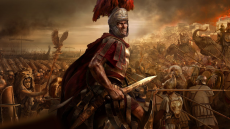
The ancient world of the Roman Republic is shrouded in the mists of time and we have very limited reliable sources as to its origins. However as we travel through time towards the mid republic and the era of the Punic Wars (the wars between Rome and Carthage) there are slightly more sources avilable and our knowledge of the period is greater and more extensive, no doubt largely because as Rome progressed and grew into a great power there was more reason to narrate its history than in its earliest days. Therefore picking up from where we left off in the early Roman Republic article, let us discover how the Republic expanded now that it controlled Italy.
Once Rome had exerted its dominance over Italy it turned to the nearby Island of Sicily and here encountered Carthage (modern day Tunisia). The Carthaginians were a great power in North Africa and were naval experts, trading with other factions worldwide thanks to their incredibly large natural harbour. Carthage was founded by Punic peoples and so the wars against Carthage (of which there were three) are named the Punic Wars and the first Punic War saw Rome fight Carthage over the island of Sicily and the city of Syracuse. King Heiro II of Syracuse asked for Roman assistance when Carthaginians besieged the city and Rome was only too happy to agree, seeing an opportunity to take new land whilst claiming that they were not being aggressive but instead defending an ally. This is known as defensive imperialism and is a term you will again discover further if you study Rome at a higher level. During the First Punic War the Carthaginians tried to use their expert naval skills to their advantage over the Romans, knowing that the Roman forces had stronger infantry on land but no naval experience. The Romans, innovative as ever, captured a Carthaginian Quinquireme (naval boat) and used it to build their own navy! The Romans had no need for ships prior to this but this is just one example of how the Romans could take other people's ideas and improve on them. Well aware that they had no experienced sailors the Romans fashioned a retractable gang plank on their ships called a Corvus (Raven) which enabled them to lock on to and board enemy ships thus turning it into a land battle! The Romans succeeded where so many other civilizations failed because they were not ignorant of foreign custom and instead observed it and used it to their advantage.

After winning the First Punic War and thus capturing Sicily the Carthaginians were forced to pay large reparations to Rome and could not afford to pay the mercenaries that they had hired to help them fight against Rome. As a result the mercenaries revolted and Rome capitalised on this opportunity, seizing both Corsica and Sardinia also. When the Republic then went on to exhaust King Pyrrhus of Epirus’ army the Romans began to exert their dominance and though they did not technically expand into other countries and invade them, their presence was unchallenged and much of Spain (then Iberia) and Greece submitted to their rule. Rather than destroying the people they conquered the Romans cleverly promised to be their protectors as long as they paid taxes to Rome and sent a certain number of their young men each month to be trained in the Roman army. This meant that the Romans were economically and militarily stable with a large income of both soldiers and money which is why despite Pyrrhus winning two victories against Rome their sheer man power had exhausted his army and he was forced to retreat.
Carthage, still bitter about the first Punic war, trusted in their great young commander Hannibal Barca (arguably one of the greatest military generals to have ever lived) to conquer Rome and restore Carthaginian honour. Hannibal surprised the Romans by going through Spain and crossing the Alps into Italy and then winning several decisive victories against them at Trebia, Trasimene and Cannae, crippling the Roman force. However when Winter came his campaign had to be halted and having lost most of his elephants and knowing his cavalry and infantry were outmatched by Rome he could not push further. Eventually the young Roman General Scipio Africanus (as he is named for defeating the African Hannibal) mustered his forces from Spain (Iberia) and faced Hannibal at the battle of Zamae in Africa, defeating him and his army. When Scipio defeated Hannibal and won the Second Punic War for Rome he was hailed as a hero and had a triumph in which he marched down the streets of Rome with his army and was treated almost like a God for his deeds. This was arguably the beginning of the fall of the Roman Republic and conversion into an Empire, but that's a story for another article and the latter Roman Republic.
The First Image shows a depiction of the Romans (on the left) fighting the Carthaginians (on the right) in one of the Punic Wars and the second picture shows the Roman territory after the First Punic War (the islands around Italy were those captured in the First Punic War). Note that the Roman land (in red) is far inferior to the Carthaginian land (in blue) but Rome's expansion developed rapidly after the First Punic War and due to their superior military might they owned most of Carthage's land by the end of the Second Punic War. The black zigzagging line moving down Italy shows Hannibal's path through Italy during the Second Punic War before he returned to Africa and was then defeated by Scipio Africanus.
Image 1: http://media.pcgamer.com/files/2013/05/Rome-2-Carthage-Panorama.jpg
Image 2: http://www.haverford.edu/classics/DCC/1250px-Western-Mediterranean-Hannibal-1.jpg

0 Comment:
Be the first one to comment on this article.